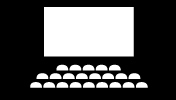

Feras Fayyad follows up his Oscar-nominated cinema-verite documentary Last Men in Aleppo (2017) with The Cave, an immersive, harrowing portrait of the heroic staff of an underground hospital in Eastern Ghouta, just outside Damascus, Syria. But this film hardly qualifies as cinema-verite. In fact, Fayyad’s movie is so shamelessly and inexplicably over-produced, it undermines the power of its subject to an unforgivable degree.
The picture opens with an artistically rendered shot that shows the city being pummeled with rockets, the sounds of the explosions ringing in the Dolby Atmos mix, that then tracks down, via CGI, below the surface of the Earth for what feels like miles to reveal the subterranean hospital where the principal action takes place. Of course, it is not unusual for a documentary to take some creative license with its opening or closing images in order to set the stage for, or close the curtain on, the reality it will show us (any more than it is for the audio heard in most nature documentaries to be almost completely manufactured by sound designers in post-production). But, in the case of The Cave, everything from the fanciful opening credits sequence, to the elaborately recorded, augmented, and re-recorded sound mix, to the Spielbergian musical score, to even segments of dialogue, shifts the focus of the film to the manipulative nature of the filmmakers rather than the heroic work of the film’s subjects.
I don’t think these extensive post-production enhancements will be noticeable only to people like me who have backgrounds in film editing. Modern audiences are savvy and can tell, even subconsciously, when something has been appropriately sweetened and when something has been fabricated. And, while I have no doubt the images Fayyad’s team captured during the many years they spent with these doctors are authentic, this documentary footage is processed to such a degree, resulting in such an awareness of artifice, that we can’t help but question everything we see on screen, wondering what is “real” and what is directorial enhancement.
The Cave follows Dr. Amani Ballor, the manager of the elaborate, seemingly well-equipped hospital beneath the constantly bombed city. We watch as she and her largely female staff of selfless medics—who have chosen to remain in Eastern Ghouta to care for its war-torn civilian population—deal with every conceivable issue that prevents their operation from functioning. The problems range from not having enough food, prescription medication, or safe operating rooms to meet the needs of their constantly growing number of patients, to the fact that in their strict Muslim society, many of the patients or families they’re trying to serve resent the fact that women are even doing this work. Offsetting this misogyny are the enlightened male doctors and the sympathetic voice messages of Dr. Ballor’s father, but the film goes out of its way to drive home the point that these women must deal with societal sexism even under the extreme conditions everyone in their community is trying to survive.
The subject and setting are fascinating, and Dr. Ballor makes a strong central figure for a film. But so often she practically looks into the camera to overtly state the themes of this film, and there are many scenes involving her and patients that feel like everyone is reading off hastily written cue cards. Perhaps some of this is simply bad translation in the subtitling? But if that’s the case, why didn’t the director spend more time on doing the best translation possible rather than creating a sound mix that could rival that of Star Wars: The Rise of Skywalker?
While we’re at it, why, after spending six years shooting roughly one thousand hours of material, is Fayyad unable to express to his viewers any clear understanding of such basic things as timeframe and geography? We’re given no idea when or how this underground hospital was built, how many entrances it has (it seems like only one, but that would be crazy), whether the people who work there also live there or if they go home at the end of a long shift. At the beginning of the movie, a CGI-enhanced drone shot flies over the city and shows us a kind of illustrated map of the underground hospital, which seems to be several large rooms connected by long warren-like passageways. But we see this image for such a short time we can’t get any sense of scale. Not only does Fayyad never return to this schematic, he never attempts to connect that abstract image with the fly-on-the-wall footage that comprises the majority of the movie. Is the Cave the size of a small town or a small warehouse? From what we’re shown inside, the place seems no bigger than a walk-in clinic apart from one long dark tunnel.
When a filmmaker chooses to make a movie about such a unique situation operating under such extreme conditions, he must provide the audience with at least some understanding of how everything works so we can grasp what’s special about it and understand why some things cease working at certain points. But in The Cave, we don’t really have a sense of how much time has passed. Of course, that also may be part of the point. When you spend most of your time below ground for so many years dealing with every conceivable emergency, time may become a relative concept. But The Cave has no narrative or dramatic arc to keep us engaged until the point when the regime of Bashar al-Assad begins using chemical weapons on civilians.
The climax of the film, in which Ballor and her team put their lives on the line as toxic chlorine gas seeps into the rooms where they’re treating dozens of children after a chemical attack, is unquestionably powerful. But it would have been far more powerful if it were not edited and scored like an action thriller. As evidence, one need look no further than another film about a hospital in Syria set during the same timeframe, Waad Al-Kateab and Edward Watts’s For Sama, released earlier this same year. For Sama is a personal account made largely on phones and consumer-grade video equipment. Both films are about women working at hospitals in burned-out cities in Syria that are under constant bombardment from the regime and its Russian allies. Both are shot by indigenous camera people living in the city who uploaded or smuggled their footage out to their director or co-director, living in a European country, who oversaw the construction of the raw material into a feature film. Both are extensively edited to give the films their form and to bring out their themes, but For Sama includes none of the Hollywood blockbuster post-production Fayyad inflicts on The Cave.
Since both of these movies were nominated for the Best Documentary
Feature Oscar, many viewers will undoubtedly see them close together; possibly
even back-to-back on consecutive days (as I did). Watching the simple
first-person truth of For Sama, belies the artifice of The
Cave to an even greater degree. Interestingly, both films end with
shots that feel nothing like the gritty realism that defines their overall
aesthetic. For Sama concludes with a shot of the filmmaker and
the child she made the movie for walking through the destroyed city of Aleppo. The
Cave ends with an underwater shot that looks like something out of a James
Cameron picture. Both final images feel digitally rendered and both, for good
or ill, feel in line with everything that’s come before. In For Sama,
the final shot is a poetic representation of a mother’s love for both her child
and her city. In The Cave, the final shot and
superimposed text is heavy-handed, polemical, and unlike anything we’ve seen in
his film up to that point. Fayyad wants us to reflect on the greater world
outside of the confined space he’s been showing us during the body of his film,
but The Cave will leave many feeling more disconnected from the conflict
in Syria than we were before.




